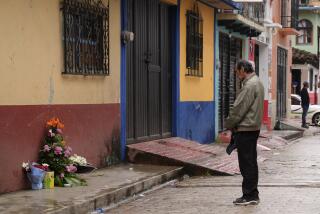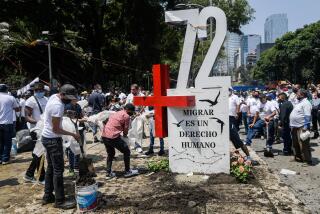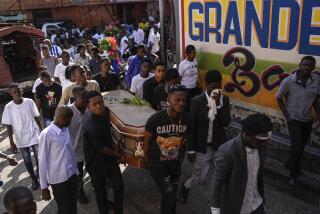Thousands Mourn at Rites for Salvador Activist
SAN SALVADOR â One at a time Friday, Mirna Perla de Anaya held her five young children up to the microphone in the Metropolitan Cathedral to thank the crowd of mourners for coming to their slain fatherâs funeral Mass.
âThank you, people of El Salvador, for helping my papi ,â the oldest daughter, 10-year-old Rosa Margarita, said through her tears.
More than 2,000 church and union activists, civil liberties advocates workers and students--the sort of people who once were the target of right-wing death squads--came to the service for Herbert Ernesto Anaya, a human rights leader who was gunned down in front of his house Monday as he prepared to take his children to school.
Priests celebrating the Mass called Anayaâs death âa symbol that speaks for so many who have diedâ in El Salvador. Masked students, meanwhile, stood at the giant doors to the cathedral and patted down men for weapons. A few shouted, âUntil the victory!â in support of the leftist guerrillas.
Anaya, 32, was coordinator of the non-government Human Rights Commission and an outspoken critic of El Salvadorâs U.S.-backed government and military. His murder has set off days of angry protest and caused leftist guerrillas to break off cease-fire talks taking place under the terms of a Central American peace plan.
Anaya was shot a day before the Legislative Assembly approved a controversial amnesty plan under the peace accord that would free political prisoners and also pardon anyone involved in the murders of the estimated 40,000 people who were the victims of military and paramilitary death squads in the late 1970s and early 1980s.
Such anonymous killings have been far less common in recent years, but Anayaâs murder has raised fear among leftist groups that death squad activity might return.
The amnesty law, to take effect Nov. 5, covers all political crimes committed before Oct. 22, and therefore would not protect the killers of Anaya if they are found. The law specifically excludes the killers of Oscar Arnulfo Romero, archbishop of San Salvador, who was shot while celebrating Mass in 1980.
Romeroâs tomb and a larger-than-life portrait of him are prominent in the cavernous, half-finished cathedral where Anayaâs funeral took place. The open casket, lined with carnations and gladiolus in vases made of powdered milk cans, lay before the pulpit.
âI want to take up the voice of Msgr. Romero and the voice of my husband to plead with all of the men who make up the security forces to stop killing their brothers,â Mirna de Anaya told mourners. âI do not ask for revenge for those who have killed my husband because I know they are poor people, too . . . . If my husband could speak to you today, he would ask you to pardon them, but he would demand that they stop the killing, stop disappearing people.â
The Human Rights Commission blames the government and armed forces for Anayaâs death. The government denies that it was responsible, and President Jose Napoleon Duarte has offered a $10,000 reward for information leading to the capture of the killers. Although he has condemned the killing, he has suggested that the left may have done it to create a martyr.
âThere is no doubt that radical sectors are in the street, doing what they have wanted for a long time. They were looking for a death to take to the streets and create terror,â Duarte said this week.
During the week, members of the leftist groups paraded the coffin with Anayaâs body past the U.S. Embassy and toward the headquarters of the military high command, where they were turned back by riot police.
Father Pedro Leoz, a Spanish priest who was one of three who spoke at the Mass, said the left did not need to kill Anaya to find a martyr.
âIt is not just one death that we have here,â Leoz said. In the provinces of Usulutan, Chalatenango and Morazan, where fighting in the eight-year civil war is heaviest, he added: âThere are plenty of dead every day.â
Father Gerhard Poter, a German priest working in poor neighborhoods of the capital, said a woman named Margarita Alas Menjivar disappeared from his parish a week ago, and the two brothers of another parishioner disappeared two weeks before that.
It was disappearances such as these, attributed to kidnaping by the death squads, that Anaya continually denounced as head of the opposition Human Rights Commission. About six weeks before his death, Amnesty International sent a telex to Duarte, expressing concern about threats against Anaya and Reynaldo Blanco Rojas, another leader of the commission.
Anaya and Blanco were jailed in May, 1986, accused of aiding the Farabundo Marti National Liberation Front guerrillas. They were released in February as two of 100 political prisoners freed in exchange for an air force colonel captured by the rebels.
Blanco said in an interview Friday that while they were in detention, Treasury Police warned that if they did not stop their human rights work they would be killed.
âThey said the only way to get these ideas out of our heads was to blow our heads off,â Blanco said.
The mourners marched to the General Cemetery behind the hearse carrying Anayaâs coffin and his widow, who walked with women in black as a new member of âthe mothers,â short for the Federation of Committees of Mothers and Families of Prisoners, the Disappeared and Assassinated.
Along the route, a few of the masked youths set fire to two trucks, commandeered nearly a dozen buses and let the air out of tires to be used in barricades.
At the grave under a mango tree, Rosa Margarita told her mother that she was going to break into tears again. She had been the one to find her father dead on the pavement, and now she was seeing him for the last time.
âMy daughter,â Mirna de Anaya told her, âthink that we are going to bury your father beneath this mango tree, and in a year, we will come collect the fruit.â
More to Read
Sign up for Essential California
The most important California stories and recommendations in your inbox every morning.
You may occasionally receive promotional content from the Los Angeles Times.










